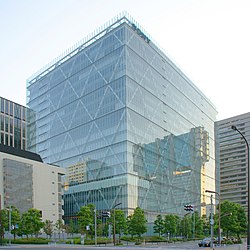Electronics industry in Japan
This article needs additional citations for verification. (October 2013) |

The Japanese electronics industry is one of the largest in the world, though the share of Japanese electronics companies has significantly declined from its peak due to competition from South Korea, Taiwan, China, and the United States.[1] Japan still has a number of companies that produce television, camcorders, audio and video players, etc.
Japanese companies have been responsible for a number of important innovations, including having pioneered the transistor radio and the Walkman (Sony), the first mass-produced laptops (Toshiba), the VHS recorder (JVC), and solar cells and LCD screens (Sharp).[2]
Major Japanese electronics companies include Akai, Brother, Canon, Casio, Citizen, Fujifilm, Fujitsu, Hitachi, JVCKenwood, Konica Minolta, Kyocera, Mitsubishi Electric, NEC, Nikon, Nintendo, Olympus, Onkyo, Panasonic, Pioneer, Ricoh, Seiko Group, Sharp, Sony, TDK, Toshiba and Yamaha.
History
This section appears to be slanted towards recent events. (August 2021) |
Japan's foreign direct investment in the consumer electronics industry was motivated by protectionism and labor costs. After three years of voluntary export restraints, seven Japanese firms located plants in the United States by 1980.[3] Japanese firms continued production of the most technologically advanced products especially in Japan but also the U.S., while shifting production of less-advanced products to developing countries in Southeast Asia.[4]
Circa 1997 Japanese children had a relatively large amount of savings, with the average having about 110,000 Japanese yen (about $900 U.S. dollars) in allowances, which stimulated purchases of electronic goods like Tamagotchi.[5]
21st century

Since the beginning of the 21st century, a number of the largest Japanese electronics companies have struggled financially and lost market share, particularly to South Korean, Taiwanese, and Chinese companies. Japanese companies have lost their dominant position in categories including portable media players, TVs, computers and semiconductors.[6] Hit hard by the economic crisis of 2008 Sony, Hitachi, Panasonic, Fujitsu, Sharp, NEC, and Toshiba reported losses amounting to $17 billion.[7] By 2009, Samsung Electronics (South Korea) operating profit was more than two times larger than the combined operating profit of nine of Japan's largest consumer electronics companies.[8] The relative decline has been ascribed to factors including high costs, the value of the yen and too many Japanese companies producing the same class of products, causing a duplication in research and development efforts and reducing economies of scale and pricing power.[9][10] Japan's education system has also been highlighted as a possible contributing factor.[11] The lack of adaptation to the Digital Revolution and the shift from hardware to software-oriented product development has also been cited.[12]
One response to the challenges has been a rise in company mergers and acquisitions. JVC and Kenwood merged (forming JVCKenwood),[13] and Renesas Technology and NEC Electronics -the semiconductors arm of NEC- to merge forming Renesas Electronics.[14] In a similar move, in 2009 Panasonic acquired a voting stock majority of Sanyo, making the latter part of the Panasonic Group. Also some of the bigger players resorted to merging some of their operations as Hitachi, Casio and NEC, and Fujitsu and Toshiba, did with their cellphone business.[15] On 15 November 2011, facing tough competition from Samsung and LG; Sony, Toshiba and Hitachi signed a deal to merge their LCD businesses, creating a new company called Japan Display by spring 2012.[16]
As of 2013, most Japanese companies no longer enjoy the same reputation they did about one to two decades ago. Currently, the international electronics consumer market is a competition between Japanese, South Korean, Chinese, Taiwanese, and American industries. Quite a few Japanese companies still have significant international market share. The future of the Japanese electronics industry is debated.[17]
See also
References
- ^ Cheng, Roger. "The era of Japanese consumer electronics giants is dead". CNET. Retrieved 22 March 2022.
- ^ "The mighty, fallen - Ex-world-beaters swallow their pride and do deals with foreign rivals". The Economist. 3 March 2011. Retrieved 17 July 2012.
- ^

This image is available from the United States Library of Congress Prints and Photographs Division under the digital ID {{{id}}}
This tag does not indicate the copyright status of the attached work. A normal copyright tag is still required. See Wikipedia:Copyrights for more information.
- ^ Ong, Aihwa (1987) [1st. pub.]. Spirits of Resistance and Capitalist Discipline: Factory Women in Malaysia. Albany, NY: State University of New York Press. ISBN 0-88706-381-0.
- ^ Sekizawa, Hidehiko (December 1997). "KALEIDOSCOPIC PATTERNS OF MASS CONSUMPTION: SHOPPING AROUND IN JAPAN". Look Japan. Archived from the original on 12 June 2002. Retrieved 1 May 2019.
- ^ "IBM Institute for Business Value - Thought Leadership - United States". archive.ph. 17 December 2012. Archived from the original on 17 December 2012. Retrieved 22 March 2022.
- ^ "Japanese electronics giants post $17b losses". ABC News. 30 January 2009. Retrieved 22 March 2022.
- ^ Simms, James (5 November 2009). "South Korea's Rising Sun". The Wall Street Journal.
- ^ "Unplugged - Once the epitome of Japan's post-war success, its electronics firms are in crisis". The Economist. 5 February 2009. Retrieved 17 July 2012.
- ^ "From summit to plummet - Once global leaders, Japanese electronics firms are tumbling". The Economist. 18 February 2012. Retrieved 17 July 2012.
- ^ "Completing one's education". The Japan Times. 10 July 2012. Retrieved 17 July 2012.
- ^ Rupert Wingfield-Hayes (2 April 2013). "What happened to Japan's electronic giants?". BBC News Asia.
- ^ Erica Ogg. "JVC, Kenwood officially hook up". CNET.
- ^ "Renesas Electronics is biggest 'non-memory' chip firm". ElectronicsWeekly.com. 2 April 2010. Retrieved 3 April 2010.
- ^ "Fujitsu and Toshiba Conclude Definitive Agreement to Merge Mobile Phone Businesses - Fujitsu Global". www.fujitsu.com. Retrieved 22 March 2022.
- ^ "Sony, Hitachi, and Toshiba Agree to "Japan Display" Joint Venture". Archived from the original on 17 November 2011. Retrieved 20 November 2011.
- ^ Junko Yoshida (22 April 2013). "Japanese electronics industry debates future amid turmoil". EE Times. UBM Tech. Archived from the original on 24 April 2013. Retrieved 26 April 2013.
External links
- Japan Electronics and Information Technology Industries Association (JEITA)
- Japan Electric Manufacturers' Association (JEMA)
- Japan Refrigeration and Air Conditioning Industry Association (JRAIA)
- Japan Electric Measuring Instruments Manufacturers' Association (JEMIMA)
- Association for Electric Home Appliances (in Japanese)
- Industrial Structure Vision 2010 (METI) (in English) (full report, Electronics and IT sectors, Functional Chemical sector (p.190) (in Japanese))
- Panasonic EH-SA31VP Spa-Quality Facial Steamer
